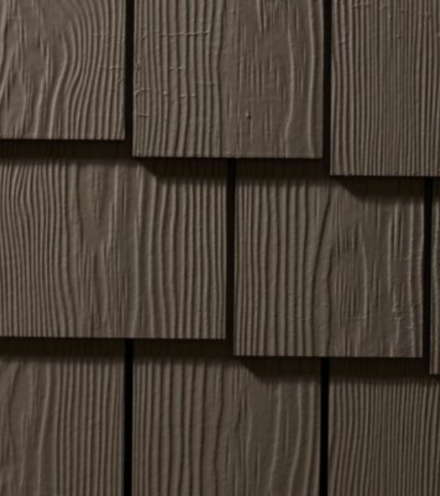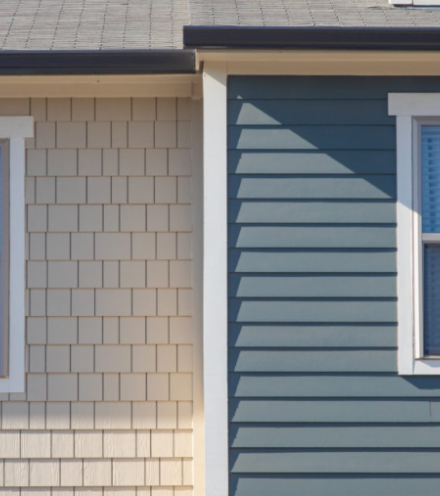When you’re completing the exterior of your home, there’s more to the facade than just the roof and siding. There are also a lot of finishing pieces that help to complete the design, appearance, and function of the exterior.
Two pieces that are installed along the roofline of your home that deserve a little attention are the fascia and soffit. Because they’re installed close to one another, many assume they’re interchangeable, but the two materials each serve a distinct purpose. Let’s break them down!
What is Fascia?

Fascia or fascia board is installed at the edge of your roof, just under the roofline. It’s usually a flat piece of trim, wider than the trim used on the rest of the home, but normally made of the same material. Occasionally, it may be decorative in style, but normally fascia is fairly subtle in presentation.
Fascia is considered the last line of defense for your roofline and rafters against the elements. It’s what your gutters attach to, and it helps block out some of the rain, snow, and wind from getting underneath your roofline.
Fascia is normally made of timber or wood, but can be found in PVC, aluminum, and vinyl as well. It’s typically installed at the same time as your roof or gutters in order to help complete this area of the home.
Some homes may not use a fascia board. It largely depends on the type and style of roofing, and whether or not you have a soffit installed. You will need a fascia board if you have traditional rain gutters.
The Best Fascia Material Options on the Market Today
Fascia is normally made of timber or wood but can also be found in PVC, aluminum, and vinyl. Our favorite fascia material on the market is fiber cement. Here’s a breakdown of each of the different material options available today:
- Wood: Wood offers a classic and natural appearance but requires regular maintenance to prevent damage from moisture and pests.
- PVC: PVC is lightweight and resistant to moisture and rot. Unfortunately, it may become brittle in extreme temperatures.
- Aluminum: Aluminum is durable and resistant to moisture, pests, and rot, though it can dent and may require repainting over time.
- Vinyl: Vinyl is super low maintenance and comes in various colors but can be prone to cracking in cold weather and may fade in sunlight.
- Fiber Cement: Fiber cement is extremely durable and mimics the look of wood without the maintenance associated with hardwood products. It’s the ideal trim option for any home improvement project.
What is a Soffit?

Most roofs will overhang the building slightly in order to offer additional protection to the home. This overhang is sometimes called the eave of the roof, and usually contains the ends of the rafters. If your home or building has an attic, you may be able to see the space where the building ends, but the roof continues to extend down past the walls.
If this space was to be left open, rain, snow, and wind could get up inside. This could do a lot of damage to the underside of the roofdeck and to the attic and interior of the home. That’s why this area is usually covered and protected by a material called a soffit.
The soffit installs under the overhang of your roof, and helps protect your roofdeck and attic from moisture. A good soffit is often perforated as well, to allow air to circulate better, removing built up moisture and helping to eliminate issues such as mold or wood rot caused by condensation.
The soffit isn’t as obvious as the fascia when you’re looking at the home from the street, but it is obvious once you get up close to the home, and look up at the underside of the roof. Without a soffit, you would see the rafters and eaves of the roof, and the home would have an unfinished appearance.
Like fascia, soffits can be made of many different materials. This area needs to be made of a material that can withstand significant moisture, as it will be dealing with the warm air from within the attic, as well as the elements outdoors. That’s why you’ll often find soffits made of materials like fiber cement, which are strong, durable, and resistant to moisture issues.
While a fascia isn’t always necessary for a home or roof, soffits generally are. Without a soffit, not only would the home not have a finished appearance, but the rafters and eaves would be exposed to the elements, and at risk for problems like wood rot, interior leaks, mold growth, and roof deck failure. Soffits also help keep insects, rodents, and other pests out of your eaves and attic. Without a soffit, your attic and eaves are essentially left open, which can lead to a lot of problems.
The Best Soffit Material Options on the Market Today
Like fascia, soffits can be made of many different materials. This area needs to be made of a material that can withstand significant moisture, as it will be dealing with the warm air within the attic and outdoor elements.
That’s why you’ll often find soffits made of materials like fiber cement, which is strong, durable, and moisture-resistant. Here’s a breakdown of each of the different material options available today:
- Wood: Wood soffits provide a beautiful, natural look but are susceptible to moisture and require frequent maintenance.
- Vinyl: Vinyl soffits are low maintenance and rot-resistant, though they can warp or melt in high heat, which is a bad mix if you live in a particularly warm area.
- Aluminum: Aluminum soffits are lightweight, low maintenance, and resistant to pests and moisture, but they can dent more easily than other materials.
- PVC: PVC soffits are waterproof and durable, which makes them a low-maintenance but higher-cost option.
- Fiber Cement: Fiber cement soffits are highly durable and resistant to fire, pests, and rot and offer a versatile aesthetic that is perfect for any home.
Fascia vs. Soffit: When to Use Them
Fascia and soffits are key components in the roofing structures of many homes. They serve both aesthetic and functional purposes by contributing to the durability and overall look of the house. Here’s a breakdown of each and when they are used:
Fascia
Fascia is used in virtually all houses to provide a finished look and to prevent moisture from entering the roof and attic space. Fascia board also provides an anchor point for the gutters, which are crucial for directing water away from the house’s foundation.
Like soffits, fascia boards are almost always necessary for roof designs. They run along the roof’s edge to provide much-needed protection against the elements, including inclement weather, extreme heat, extreme cold, and pests.
Soffit
Soffits are used when there is a visible roof overhang. If your roof extends beyond the walls of your home, the underside will typically be covered with soffit. They are particularly important for homes because they provide much-needed attic ventilation and seal off the underside of the roof from the elements and wildlife.
Without a soffit, not only would the home not have a finished appearance, but the rafters and eaves would be exposed to the elements. This would put them at risk for problems like wood rot, interior leaks, mold growth, and roof deck failure. Soffits also help keep insects, rodents, and other pests out of your eaves and attic.
Which One Should You Use?
In short, the answer is simple: you should use both fascia and soffit, especially if you’re working with a modern home. While fascia is used to protect the edges of the roof and provide a mounting point for gutters, soffits cover the underside of the roof overhang for protection, ventilation, and aesthetic benefits. Both are essential for modern roof construction.
Protect Your Roof

In most homes, you’ll have both a fascia board and a soffit working together to protect your roof and eaves from moisture and to help give your home a finished appearance.
While a fascia board is not always necessary, however, to the installation and performance of a roof and home, soffits will help protect your home and keep it functioning properly, while also giving it the finished look you desire. Make sure you install a durable soffit, such as one made from fiber cement, to help ensure your home’s continued performance over time.
The experts at Allura are ready to help you select the best materials for your next project. For more info on soffits and fascia boards,contact Allura today.




